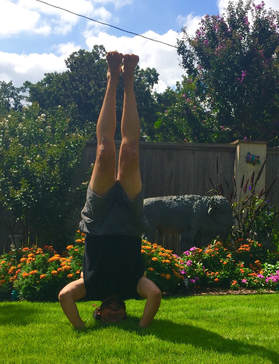
When I first began doing yoga, a teacher introduced me to headstand. She was a gifted, compassionate and excellent teacher who started her students with headstand at the wall. The first time I did this pose, I felt, intuitively, this was something I wanted to experience more of. Years later, I do headstand for a full hour at a time, usually 3 or times a week. I always feel superb after my one hour session. My research indicates that headstand delivers many benefits. Here are just ten:
1. Produces richer oxygenated blood for the brain. In headstand, the blood absorbs 33% more oxygen which directly benefits and nourishes the brain as well as other internal organs
2. Significantly reduces risk of stroke. Research reveals that stroke rarely occurs in those who consistently do headstands.
3. Increases core strength. In order to hold a prolonged headstand core muscles (such as obliques, the rectus abdominus and the transverse abdominus) are engaged.
4. Stimulates the lymphatic system. This network of nodes and fluids removes waste products from the blood. Headstand energizes the lymphatic system helping and hasting the removal of toxins from the body.
5. Lifts depression and generates feelings of happiness. Headstand stimulates the pituitary gland which is responsible for releasing endorphins (the body's 'happy' hormones).
6. Reduces anxiety, tensions and stress by lowering levels of cortisol, the stress hormone.
7. More efficient breathing. Headstand facilitate a more complete exhalation fully emptying the lungs. In turn, this allows for a greater intake of fresh oxygen.
8. Face lift. Headstands can reduce facial wrinkles by reversing the effects of gravity allowing the skin to “rest” in the other direction. Also, this inversion increases circulation to the face bringing fresh nutrients and oxygen rejuvenating the skin while removing wrinkle causing toxins.
9. Strengthens the neck, spine and shoulders significantly.
10. Reverses the impact of gravity on inner organs. Being constantly upright tends to compress the organs. Headstand reverses this pattern giving the organs more room and allowing them to “space out”.
If you wonder how a headstand can provide so many benefits, here's a good explanation of the physiology from the Arhanta Yoga, an Indian yoga teacher training organization:
When you come into headstand, not only the body inverts, but the blood pressure as well. The pressure changes in the head, neck, shoulders, veins, arteries, lungs as well as legs. This change in blood pressure forces the body to react in order to maintain balance in the different body systems. The muscles and tissues of upper extremities are also stressed and activated.
Now maybe some alarm bells are going off as you hear that the blood pressure to the head increases. Luckily our body has very intricate and strong systems to make sure that the body and the brain stay safe. If you are physically well and your practice with the help and guidance of an experienced teacher headstand is very safe and beneficial. Due the reversal of the blood pressure – when in Headstand the blood pressure towards the head increases and in the feet and legs reduces to almost zero – we can see incredible physiological benefits. In fact according to recent clinical research, inversions improve the brains performance by 14%, and regular inversions do really improve concentration, memory, observation and clarity of thought and can counter-act depression and anxiety. Furthermore inversion therapy may even play a serious role in arresting the brain’s “aging process.”
Much of mental deterioration can be traced to poor blood pressure and hardening of the arteries, both of which reduce oxygen flow. Thus, with regular inversion therapy, we can overcome these risk factors and keep the mind from sliding into dementia.
(please feel free to re-post and/or link to your social media)
 RSS Feed
RSS Feed